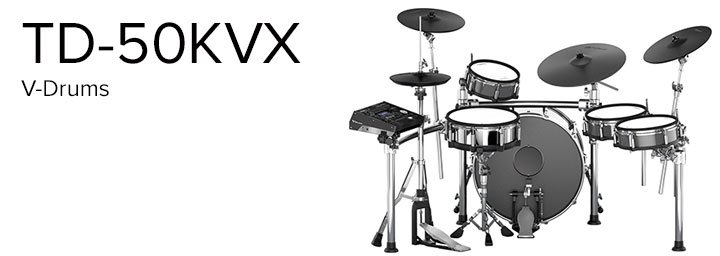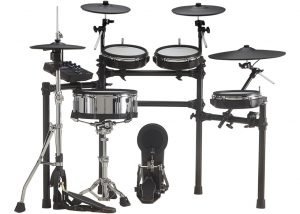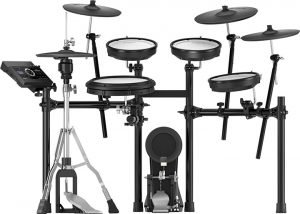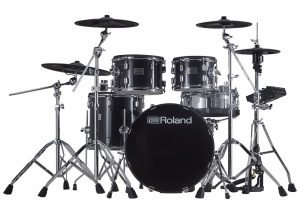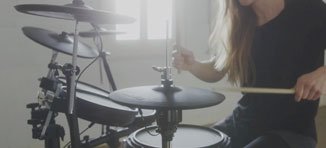Here are 4 fun things you can do with V-Drums!
- Add hi-hats easily to any part of the kit
- Sample your own sounds of any type just using your phone
- Create and trigger your own drum loops
- Record your own cymbal collection into your V-Drums
Here we’ll use a TD-27KV kit but these same techniques apply to many other kits in the V-Drums range including the most popular TD-17 series.
Let’s go through each one step by step now and get the fun started.
Add Hi-Hats to your kit easily
Adding a hi-hat to an acoustic kit is a pain. You need to choose exactly which hi-hats you need that will work for all the music you’ll play.
If you want open and close foot control, you’ll need a hi-hat remote pedal system and clamp and then find where and how to mount it in your kit. None of these things is cheap or easy.
Let’s see how you can do it with V-Drums super fast.
See here how to add another physical trigger pad to your kit.
Here's how to add Hi-Hats to your V-Drums kit in 4 simple steps
- Choose the V-Drums trigger you want to use as a hi-hat.
- Turn off H&R (head and rim link) to just change the rim sound to hi-hat
- In the instrument page, select a hi-hat
- Do the same for any other trigger zone and sound you like.
- PLAY!
“Turn any V-Drums TD-27 or TD-17 trigger zone into a hi-hat or any other sound”
Put your own cymbals into V-Drums
Using V-Drums doesn’t mean saying goodbye to your acoustic drums and cymbals. Record your collection and play the sounds directly from your kit. Use a microphone and recording interface if available but if not, just use your phone and record via Bluetooth directly into the module.
Most phones have a pretty decent recording capability and although it won’t give you the same quality as a dedicated audio interface and stereo studio microphones, it does give you more creative choices and mobility to record interesting sounds anytime that you can use musically. The eq and compression characteristics of the phone also enhance the audio in unpredictable and fun ways.
Record your own cymbal sounds with these easy steps
- Using the voice/microphone end of the phone, record the cymbal.
- Pair your phone via Bluetooth
- Use the song recorder to start recording on the module and playback the recording from your phone
- Export the recording in the module to SD Card
- Import the recording as a user WAV and edit the volume, pitch/speed
- Edit the sample start/end for instant start
- Choose the trigger zone and assign the new user sample to it
- PLAY!
“Use your phone to record your own cymbal sounds into your V-Drums kit!”
Cymbal Recording Tips
- Do some test recordings to find the ideal recording position. Notice how cymbals sound smoother when recorded from directly above and harsher and more aggressive from the side.
- Make the cymbals sustain longer with less fade by gradually moving your recording device closer to the cymbal as it naturally fades in volume.
- To shorten the cymbal sound, gradually move the phone further away as it decays or use your other hand or finger tips on the cymbal to shorten the decay. This will also use less space in the module and be faster to import.
- Experiment with mallets, sticks, brushes and even chop sticks or rubber balls on the end of a stick.
- Try stacking cymbals and adding beads and cymbal sizzles for interesting new sounds
- Use a violin bow on the edge of the cymbal to make it sing like a wineglass
- Dip gongs and cymbals in a bucket of water after you hit them to create interesting pitch bending effects
Create and Trigger Your Own Drum Loops with V-Drums
You’re a drummer and love to play right? Why use someone else’s loops when it’s faster and more rewarding to do it yourself?
Use the song recorder to capture some playing then bring it back in to trigger it from the kit. See how to do it here!
Record and Trigger Your Own Performances with these 5 Simple Steps
- Press record on the module and play anything
- Export the recording to SD Card
- Import the recording as a User WAV into the module
- Assign the user WAV to any trigger zone.
- Edit the sample
- PLAY!
“Record your own drum and percussion loops and trigger them from the V-Drums kit”.
Use anything you have around the house to make percussion loops
Remember how much fun it was as a child to bang on pots and pans? Why stop as an adult? Record anything you have lying around or raid the kitchen to create loops that are unique sounding and fun to play with.
Here’s how.
Here's how to Record Anything into V-Drums
- Use your phone to record a performance
- Pair your phone to the module via Bluetooth
- Use the song player to record your performance into the module as a WAV
- Export the recording to SD Card
- Import the performance as a user WAV sample
- Edit the user sample and assign it to a trigger zone
- PLAY!
If this has excited you with the possibilities, that was the aim! For a jump in quality, consider getting yourself a nice microphone and audio interface. See the links below on products related to this topic.
Now go and record something!

